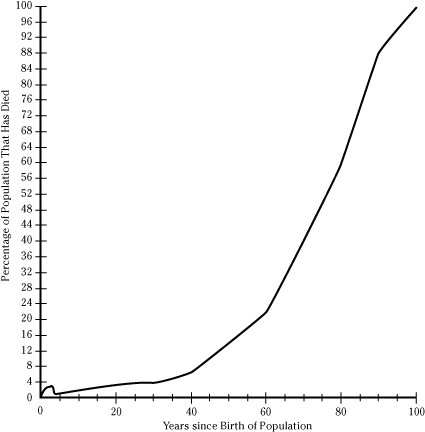Most students find the data representation questions in the Science section to be the easiest type of passage on the ACT — not coincidentally because it usually has the least text. The ACT has two to three data representation passages, each with just five to six questions.
Here's a sample data-representation passage for you to try.
Sample passage and questions
Very few humans live to the age of 100. In other words, almost all members of the human population who were born in a given year will die within 100 years. Scientists, health professionals, and life insurance agents are interested in examining how many people in a population will live to be a certain age. One way to measure this information is to look at how much of the population has died after a certain number of years. A graph documenting the results of one such study is presented here.

According to the figure, approximately what percentage of the human population lives to at least 80 years of age?
(A) 10 percent
(B) 40 percent
(C) 60 percent
(D) 80 percent
The increase in percentage of deaths is highest for which of the following intervals?
(F) 0 to 20 years
(G) 20 to 40 years
(H) 40 to 60 years
(J) 60 to 80 years
Answers and explanations
The correct answer is Choice (B).
Not to worry. This question is a basic test of your graph-reading skills, with a little twist thrown in. First, find 80 years on the horizontal axis. Go straight up from this year (your ACT answer sheet can serve as a straight edge) until you hit the plotted curve. Next, go straight to the left to find the percentage of people who have died. But watch out: If you chose Choice (C), you fell for the trap. The question asks for the percentage alive after 80 years. So you must subtract 60 percent from 100 percent to get 40 percent.
Get into the habit of circling precisely what the question is asking for. In this case, circle the word alive so that you keep in mind that the percentage alive is what the question wants.
The correct answer is Choice (J).
The percentage climbs from 0 percent to only 10 percent or so from 0 to 40 years, so Choices (F) and (G) are out. A good look at the graph shows much bigger increases in later intervals. The graph climbs from about 10 percent to 25 percent (an increase of 15 percent) between 40 and 60 years and from about 25 percent to 70 percent (an increase of 45 percent) between 60 and 80 years. (Quickly looking at the slope of the graph provides the answer for this question.)

